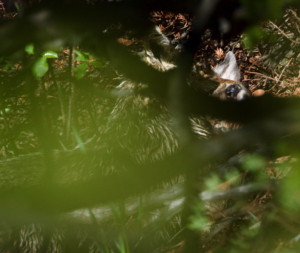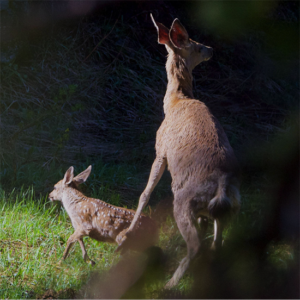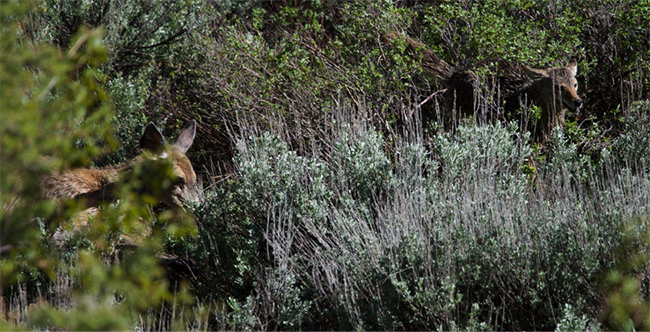By Larry Barnes

A June night of lightning and rain dawned clear in the Pioneer Mountains. The sun warmed the land and steam rose, backlit in the shade of spruce. Birds sang a little louder above the din of the swollen and lively creeks to make their case for mates, parenthood, and immortality. The spring sounds of abundance drowned out those made by footsteps on wet earth and the air was heavy with scent that brought hope to predators and fear to prey.
Here at the confluence of two creeks was the cover and bounty of willows and spruce, patches of sun, a small meadow, and higher up, sagebrush steppe and mountain shrub. A life-and-death drama was unfolding between four mammals, silently at first. But a new sound erupted, one that is known to every carnivore—the cry of prey in the jaws of a predator.
Perhaps I should have minded my own business, but the wail was as alluring to me as it was to any other creature that had ever tasted meat. For most of human history, a person approaching such sounds would have held a spear or bow, for opportunity was knocking. I had a camera.

Like my paleolithic ancestors, I approached with care and curiosity toward the commotion of large mammals, breaking twigs, and high stakes. And there was a doe, tongue lolling from the side of her panicked face with her offspring in grave danger as she did her best to fend off two coyotes. Armed with sharp hooves and a mama grizzly attitude, she attempted to drive off one coyote in the saturated underbrush as the other attacked her fawn. Only then, with the pressure and pain of a coyote’s teeth pressing into its flesh would the fawn break its code of silence and bawl with the sound of nature’s dinner bell.
Death was near and almost certain. The fawn’s best chance of survival was to call in a larger and more fearsome predator and then escape, wounded but alive, in the following confusion. A black bear, a wolf, a lion, or a wolverine might have enthusiastically entered the fray to see if an easy meal was at hand.
It is common for prey species to have some kind of plaintive, near-death sound that travels far, even though the tactic probably seldom saves its life. But it needn’t work often to be a behavior advanced by natural selection. If you are hopeless and about to die, why not call in a larger predator? And if by slim chance you do survive, so too will the genes behind the last-ditch behavior that saved your life.
Predator calls have been used by people for as long as we have been hunting. Today you can buy them in hunt shops, little devices that you blow through to emulate a dying rabbit, a doe, or any manner of suffering creature that might bring a curious predator within range.
One can even broadcast recorded sounds of a dying, suffering creature into the wild, while hunkered down with a rifle. This is one of several ways Idahoans can legally attract and kill wolves. (Use of electronic calls to attract waterfowl and upland game birds is prohibited, however.) I wonder about the provenance of these recordings and imagine someone with a microphone and Gestapo-like detachment doing unthinkable things to elicit the most perfect, terror-driven screams from a tortured fellow mammal.
My presence was noticed by the coyotes and the doe. Only the fawn, whose small head was gripped at least once by the long jaws of a coyote, may have overlooked me. All cast members that morning, obedient to their biology, played their parts. The coyotes, their own hungry pups at a den, ignored the doe’s attempt to lure them away and instead followed their noses to the hidden, wet fawn. The doe marshaled her inner warrior and attacked. When all was lost, the fawn initiated the nuclear option. There happened to be a more senior predator nearby (me) that was drawn, as moth to a flame, to the calamity. As a result, the fawn lived to see another day, or a few more hours, or a lifetime, the coyotes missed a meal, and I told their stories.
Larry Barnes retired from 26 years as a biology teacher at Wood River High School and is now transitioning to spending more time exploring the natural world.



